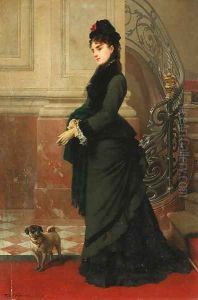Antoine-Jean-Etienne Faivre Paintings
Antoine-Jean-Etienne Faivre was a French painter born on May 6, 1830, in Besançon, France. He is primarily known for his genre scenes, allegorical works, and portraits. Faivre's artistic journey began under the guidance of local artists in his hometown, where he nurtured his initial passion for art. Seeking to further his skills and artistic education, he eventually moved to Paris to study under renowned artists of the time.
In Paris, Faivre became a student of François-Édouard Picot and Felix-Joseph Barrias, both influential figures in the academic art scene of the 19th century. Under their tutelage, Faivre honed his technique, embracing the academic style that emphasized classical themes, meticulous composition, and a polished finish. His works were characterized by their detailed realism, vibrant color palette, and often incorporated symbolic or moral themes, a hallmark of academic art.
Faivre participated in the Paris Salon, the official art exhibition of the Académie des Beaux-Arts in Paris, where his works were regularly exhibited from 1857 onwards. These exhibitions were critical to an artist's recognition and success at the time, and Faivre's participation helped establish his reputation in the French art world. His genre scenes, which often depicted everyday life with a sentimental or moralistic tone, were particularly well-received by the Salon audience and art critics.
Throughout his career, Antoine-Jean-Etienne Faivre received several honors and awards. His contributions to French art were recognized when he was awarded medals at the Salon exhibitions, reflecting the esteem in which his work was held by his contemporaries. Despite this recognition, Faivre did not gain the same level of lasting fame as some of his peers.
Faivre's artistic output declined in his later years, and he passed away on August 22, 1900, in Algiers, Algeria. While his work may not have achieved the same enduring legacy as some of his more famous contemporaries, Faivre's paintings remain a testament to the academic art movement of the 19th century. They continue to be appreciated for their technical skill and as a reflection of the societal values and artistic tastes of his era.
